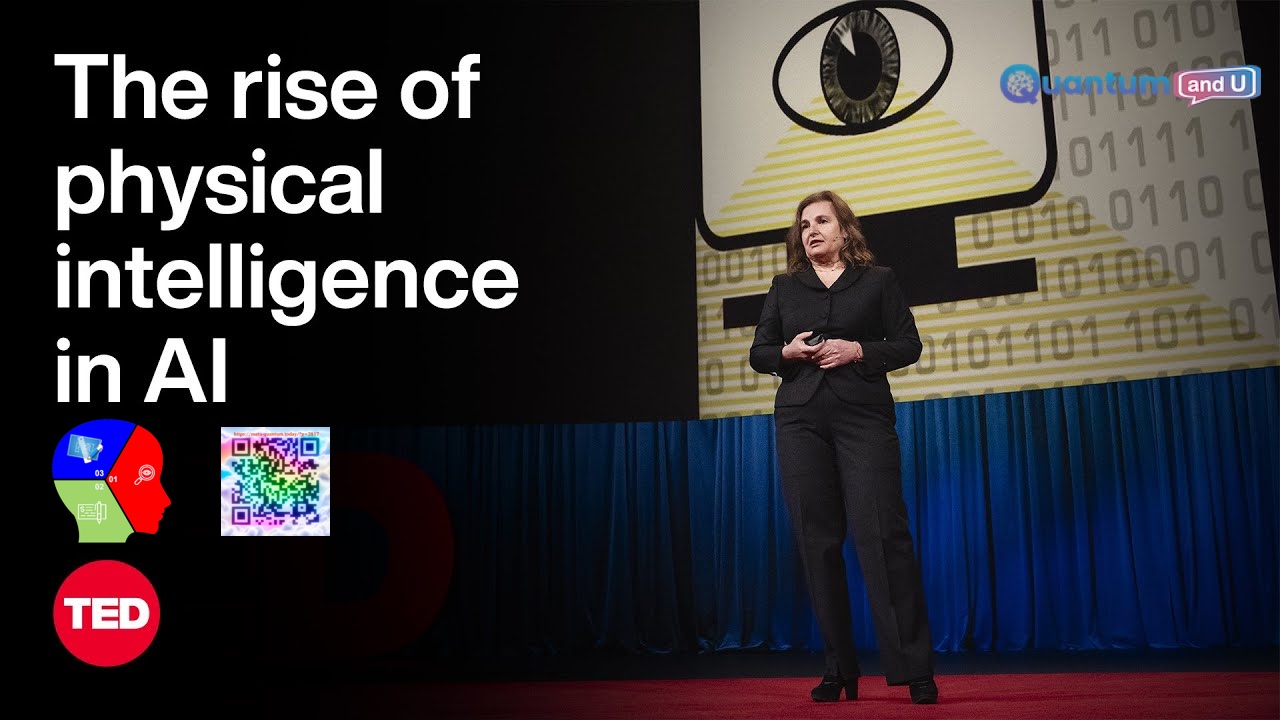
Introduction:
Daniela Rus shares a humorous anecdote from her student days, illustrating the difficulty of bridging the gap between digital intelligence and physical tasks. She then introduces the concept of physical intelligence, a fusion of AI’s digital capabilities with robotics, enabling machines to interact with the real world.
Physical Real World NOW with AI, Life with AI:
Artificial intelligence (AI) is already woven into the fabric of our physical world in 2024, and it’s likely you interact with it more than you realize. Here are some examples:
Daily Encounters:
- Smart assistants: Voice assistants like Siri and Alexa control smart devices in your home, answer questions, and even order groceries.
- Smartphones: AI personalizes your experience by filtering news feeds, recommending apps and music, and correcting your typos.
- Transportation: Ride-sharing services use AI algorithms to optimize routes and dispatch drivers, and self-driving cars (still under development in many places) rely heavily on AI.
Beyond the Obvious:
- Manufacturing: AI helps manage complex supply chains, optimize factory processes, and perform quality control inspections.
- Healthcare: AI assists doctors in analyzing medical scans, developing treatment plans, and even performing some surgeries with robotic precision.
- Finance: AI helps detect fraud, personalize investment recommendations, and automate financial tasks.
Life with AI can be both beneficial and pose some challenges:
Benefits:
- Efficiency: AI automates tedious tasks, freeing us for more creative work and leisure.
- Accuracy: AI analyzes vast amounts of data to improve decision-making and reduce errors in various fields.
- Innovation: AI is constantly evolving, leading to new solutions and advancements in many areas.
Challenges:
- Job displacement: As AI automates tasks, some jobs may become obsolete.
- Bias: AI algorithms can inherit biases from the data they’re trained on, leading to unfair outcomes.
- Transparency: Complex AI systems can be difficult to understand, raising concerns about accountability.
TED Video:
Related Sections to TED Video above:
- AI’s Transition to the Physical World:
- Rus discusses the current separation between AI and robotics, emphasizing the need to integrate digital intelligence with physical machines.
- She introduces the concept of physical intelligence, which leverages AI to enhance the capabilities of robots in real-world environments.
- Liquid Networks:
- Rus presents “liquid networks,” a novel AI approach inspired by the neural structure of C. elegans.
- Liquid networks offer more compact and explainable solutions compared to traditional AI systems, enabling machines to adapt and improve continuously.
- Text-to-Robot and Image-to-Robot Transformation:
- Rus explains how her team developed systems that translate text and images into physical robot designs.
- This approach accelerates prototyping and innovation cycles by reducing time and resource requirements.
- Human-to-Robot Learning:
- Rus demonstrates how robots can learn from human demonstrations using physical data collected in a kitchen environment.
- This method enables machines to perform tasks with grace, agility, and adaptability.
Impact to SEA and opportunities:
Southeast Asia is a region ripe with potential for AI to create positive change. How AI is impacting the region and the opportunities:
Economic Growth:
- Boosting GDP: Estimates suggest AI could add up to $1 trillion to Southeast Asia’s GDP by 2030, with sectors like manufacturing and agriculture seeing significant benefits.
- Efficiency gains: AI can automate tasks in logistics, human resources, and other areas, streamlining businesses and boosting productivity.
Agriculture:
- Precision farming: AI can analyze data to optimize fertilizer and water usage, predict crop yields, and even detect diseases in plants.
- Weather prediction: AI-powered weather forecasting can help farmers prepare for droughts, floods, and other disruptions.
Hospitality:
- Guest Experience Personalization: AI chatbots can answer guest inquiries 24/7, personalize recommendations for local attractions, and even handle room service orders.
- Revenue Management & Pricing Optimization: AI can analyze data to predict demand and set dynamic pricing strategies that maximize hotel revenue.
- Targeted Marketing & Guest Segmentation: AI can analyze guest data to identify target markets and personalize marketing campaigns for different guest segments.
- Operational Efficiency: AI can automate tasks like scheduling staff, managing inventory, and streamlining back-office operations, freeing up staff time for guest interaction.
Public Services:
- Disaster management: AI can analyze data to predict natural disasters and optimize emergency response efforts.
- Personalized education: AI tutors can provide students with individualized learning experiences and identify areas where they need extra help.
Challenges and Considerations:
- Digital Divide: Unequal access to technology could exacerbate existing inequalities in the region.
- Workforce training: Governments and businesses need to invest in training programs to equip workers with the skills needed for an AI-powered economy.
Opportunities and the Road Ahead:
- Focus on ethical AI: Developing and deploying AI in a responsible manner is crucial to ensure it benefits everyone.
- Collaboration: Regional cooperation on AI development and policy can accelerate progress and ensure shared benefits.
- Investing in infrastructure: Building a robust digital infrastructure is essential for AI to reach its full potential in Southeast Asia.
Conclusion:
In her TED talk, Rus concludes by emphasizing the transformative potential of physical intelligence. She imagines a future where AI-powered machines enrich our capabilities and interactions with the world. She encourages viewers to contribute to this technology’s advancement for the betterment of humanity and the planet.
AI’s significant impact on our physical world continues to grow. With such powerful technology, it’s crucial to understand both its benefits and challenges to ensure its use for good.
By addressing these challenges and seizing the opportunities, Southeast Asia could leverage AI to become a global leader in innovation and economic growth.
Key Takeaway Points:
- AI is evolving beyond the confines of digital screens, merging with robotics to create physically intelligent machines.
- Liquid networks offer a new approach to AI that enables continuous adaptation and improved performance in real-world settings.
- Text-to-robot and image-to-robot transformations streamline the prototyping process and accelerate innovation.
- Human-to-robot learning facilitates graceful and agile machine behavior, expanding the range of tasks robots can perform.
Related References:


